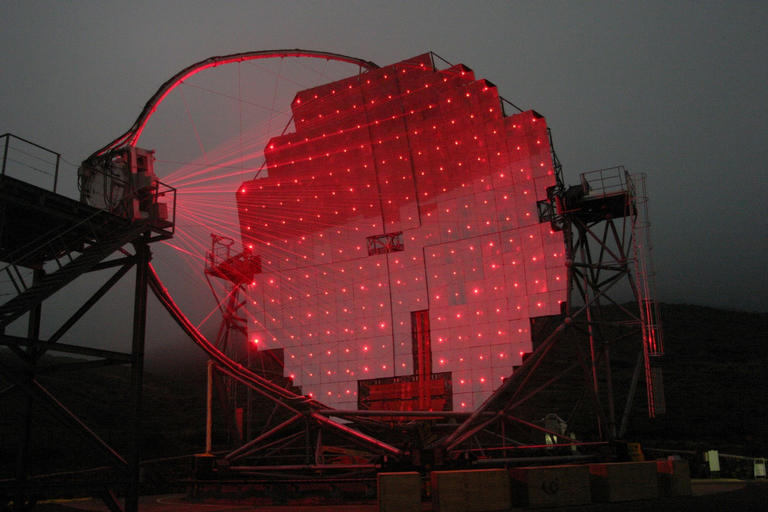|
Major Atmospheric Cerenkov Experiment Telescope
Major Atmospheric Cerenkov Experiment Telescope (MACE) is an imaging atmospheric Cerenkov telescope (IACT) located near Hanle, Ladakh, India. It is the highest (in altitude) and second largest Cerenkov telescope in the world. It was built by Electronics Corporation of India, Hyderabad, for the Bhabha Atomic Research Centre and was assembled at the campus of Indian Astronomical Observatory at Hanle. It was originally scheduled to become operational by 2016, but plans were pushed back to begin operations in 2020. Due to the remote location and harsh environment of the site, the telescope is remotely operated. A dedicated 240 kW solar power station was built to fulfil the power requirements of the observatory. The telescope is the second-largest gamma ray telescope in the world and will help the scientific community enhance its understanding in the fields of astrophysics, fundamental physics, and particle acceleration mechanisms. The largest telescope of the same class is t ... [...More Info...] [...Related Items...] OR: [Wikipedia] [Google] [Baidu] |
IACT
IACT (imaging atmospheric r airCherenkov telescope r technique is a device or method to detect very-high-energy gamma ray photons in the photon energy range of 50 GeV to 50 TeV. As of 2017, there are four operating IACT systems: High Energy Stereoscopic System (H.E.S.S.), Major Atmospheric Gamma Imaging Cherenkov Telescopes (MAGIC), First G-APD Cherenkov Telescope (FACT), and Very Energetic Radiation Imaging Telescope Array System (VERITAS). The Major Atmospheric Cerenkov Experiment Telescope (MACE) is under construction in Hanle, Ladakh, India and is set to be the highest and second-largest IACT. The Cherenkov Telescope Array (CTA) is a multinational project to build next-generation IACTs and is scheduled to begin data collection in 2022. Background Due to the rapidly falling flux of gamma-ray photons from cosmic sources in this energy regime, space-based detectors become ineffective due to their small collection areas which are often limited to some tens o ... [...More Info...] [...Related Items...] OR: [Wikipedia] [Google] [Baidu] |
List Of Highest Astronomical Observatories
This is a list of the highest astronomical observatories in the world, considering only ground-based observatories and ordered by elevation above mean sea level. The main list includes only permanent observatories with facilities constructed at a fixed location, followed by a supplementary list for temporary observatories such as transportable telescopes or instrument packages. For large observatories with numerous telescopes at a single location, only a single entry is included listing the main elevation of the observatory or of the highest operational instrument if that information is available. History of high altitude astronomical observatories Prior to the late 19th century, almost all astronomical observatories throughout history were located at modest elevations, often close to cities and educational institutions for the simple reason of convenience. As air pollution from industrialization and light pollution from artificial lighting increased during the Industrial Revolut ... [...More Info...] [...Related Items...] OR: [Wikipedia] [Google] [Baidu] |
Leh District
Leh district is a district in Indian-administered Ladakh in the Kashmir#Dispute, disputed Kashmir-region. The application of the term "administered" to the various regions of Kashmir and a mention of the Kashmir dispute is supported by the WP:TERTIARY, tertiary sources (a) through (e), reflecting WP:DUE, due weight in the coverage. Although "controlled" and "held" are also applied neutrally to the names of the disputants or to the regions administered by them, as evidenced in sources (h) through (i) below, "held" is also considered politicized usage, as is the term "occupied," (see (j) below). (a) (subscription required) Quote: "Kashmir, region of the northwestern Indian subcontinent ... has been the subject of dispute between India and Pakistan since the partition of the Indian subcontinent in 1947. The northern and western portions are administered by Pakistan and comprise three areas: Azad Kashmir, Gilgit, and Baltistan, the last two being part of a territory called the Nort ... [...More Info...] [...Related Items...] OR: [Wikipedia] [Google] [Baidu] |
Buildings And Structures In Ladakh
A building or edifice is an enclosed structure with a roof, walls and windows, usually standing permanently in one place, such as a house or factory. Buildings come in a variety of sizes, shapes, and functions, and have been adapted throughout history for numerous factors, from building materials available, to weather conditions, land prices, ground conditions, specific uses, prestige, and aesthetic reasons. To better understand the concept, see ''Nonbuilding structure'' for contrast. Buildings serve several societal needs – occupancy, primarily as shelter from weather, security, living space, privacy, to store belongings, and to comfortably live and work. A building as a shelter represents a physical separation of the human habitat (a place of comfort and safety) from the ''outside'' (a place that may be harsh and harmful at times). buildings have been objects or canvasses of much artistic expression. In recent years, interest in sustainable planning and building practi ... [...More Info...] [...Related Items...] OR: [Wikipedia] [Google] [Baidu] |



